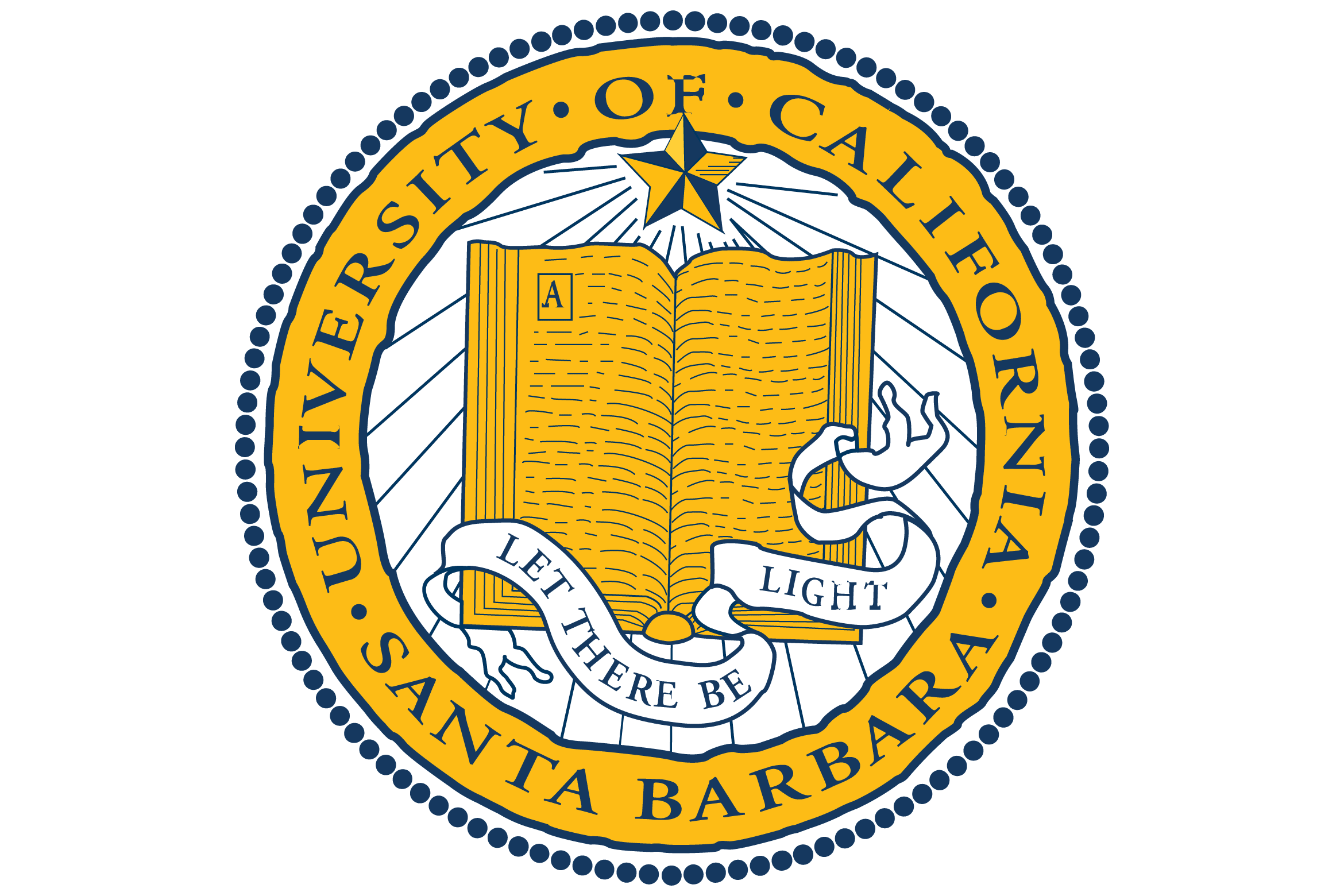The asymptotic geometry of $G_2$-monopoles
Ákos Nagy (UCSB)
Joint work with Daniel Fadel & Gonçalo Oliveira.
arXiv: 2009.06788
this talk can be viewed at: akosnagy.com/talks/g2talk/g2monopoles.html

Santa Barbara, California
Friday, October 9, 2020.
$G_2$-manifolds
- $(X, \varphi)$
- $X$: smooth, oriented 7-manifold.
- $\varphi \in \Omega_X^3$ is nondegenerate: defines a metric, $g_\varphi$ (in a nonlinear way):
\begin{equation}
\forall v \in T_x X : \quad (\iota_v \varphi) \wedge (\iota_v \varphi) \wedge \varphi = 6 |v|_{g_\varphi}^2 \mathrm{vol}_{g_\varphi}.
\end{equation}
- Linear PDE: $\mathrm{d} \varphi = 0$.
- Nonlinear PDE: $\mathrm{d} \ast_{g_\varphi} \varphi = 0$.
- $\mathrm{Hol}^{g_\varphi} \leqslant G_2$.
- Model for $T_x X$: $\mathbb{R}^7 \simeq \mathrm{Im} (\mathbb{O})$.
- $(X, \varphi)$
- $X$: smooth, oriented 7-manifold.
- $\varphi \in \Omega_X^3$ is nondegenerate: defines a metric, $g_\varphi$ (in a nonlinear way): \begin{equation} \forall v \in T_x X : \quad (\iota_v \varphi) \wedge (\iota_v \varphi) \wedge \varphi = 6 |v|_{g_\varphi}^2 \mathrm{vol}_{g_\varphi}. \end{equation}
- Linear PDE: $\mathrm{d} \varphi = 0$.
- Nonlinear PDE: $\mathrm{d} \ast_{g_\varphi} \varphi = 0$.
- $\mathrm{Hol}^{g_\varphi} \leqslant G_2$.
- Model for $T_x X$: $\mathbb{R}^7 \simeq \mathrm{Im} (\mathbb{O})$.
The Donaldson–Segal program
- $N^4 \subset X$ is a coassociative submanifold, if $\psi|_N = \mathrm{vol}_N$ ($N$ is $\psi$-calibrated).
- Donaldson–Segal: Potential invariants for $G_2$-manifolds by counting coassociatives. (Hard!)
- Conjecturally equivalent and seemingly easier:
count $G_2$-monopoles, $(\nabla, \Phi)$. - Intuitively, the correspondence between coassociatives and monopoles:
$N = \Phi^{- 1} (0)$. - In simple cases these objects are computable and agree (Oliveira).
- First step to prove more generally: analytic properties; e.g. asymptotics.
Yang–Mills–Higgs theory
- $P \rightarrow X$: principal $SU (2)$-bundle.
- Let $\nabla$ be a connection and $\Phi$ a section of $ad (P)$.
- The Yang–Mills–Higgs energy: \begin{equation} E (\nabla, \Phi) = \int\limits_X \left( |F_\nabla|^2 + |\nabla \Phi|^2 \right) \mathrm{vol}_{g_\varphi}. \end{equation}
- The Yang–Mills–Higgs equations: \begin{equation} \mathrm{d}_\nabla^* F_\nabla = [\nabla \Phi, \Phi], \quad \& \quad \nabla^* \nabla \Phi = 0. \end{equation}
- Harmonicity $\Rightarrow$ noncompactness (or boundary) is needed for interesting solutions.
Yang–Mills–Higgs theory on $G_2$-manifolds
- Let $\ast_{g_\varphi} \varphi = \psi \in \Omega_X^4$.
- $\exists$ special Yang–Mills–Higgs fields, called $G_2$-monopoles: \begin{equation} \ast_{g_\varphi} (F_\nabla \wedge \psi) = \nabla \Phi. \end{equation}
- $F_\nabla = F_\nabla^7 + F_\nabla^{14}$ ("vector" + "$G_2$").
- $\ast (F_\nabla \wedge \psi) \sim F_\nabla^7$.
- intermediate energy: \begin{align} E^\psi (\nabla, \Phi) &= \int\limits_X (|F_\nabla \wedge \psi|^2 + |\nabla \Phi|^2) \mathrm{vol}_{g_\varphi} \\ &= \int\limits_X (|\ast_{g_\varphi} (F_\nabla \wedge \psi) - \nabla \Phi|^2) \mathrm{vol}_{g_\varphi} + \mbox{boundary intergal (topological)} \end{align}
Asymptotically conical $G_2$-manifolds
- $(X, \varphi)$ is asymptotically conical (AC).
- AC: there is a compact manifold-with-boundary $K^7 \subset X$, such that \begin{equation} (X - K, g_\varphi|_{X - K}) \sim ([R, \infty) \times \Sigma, \mathrm{d}r^2 + r^2 g_\Sigma). \end{equation}
- Cheeger–Gromoll: $\Sigma$ has one component (which is a nearly Kähler 6-manifold).
Our main result
Theorem (Asymptotics of $G_2$-monopoles on AC manifolds; Fadel–N–Oliveira '20)
Let $(\nabla, \Phi)$ be a $G_2$-monopole such that
- $E^\psi (\nabla, \Phi) < \infty$,
- $r^2 F_\nabla^{14} \in L^\infty (X)$.
Then
- $|\Phi| \rightarrow m > 0$, (the mass of the monopole)
- $|\nabla \Phi| = O (r^{- 6})$, (sharp)
- $|[F_\nabla, \Phi]|$ decays exponentially,
- $(\nabla, \Phi)|_{\Sigma_R} \rightarrow (\nabla^\infty, \Phi^\infty)$, (in some gauge)
- $\nabla^\infty \Phi^\infty = 0$,
- $\nabla^\infty$ is pseudo-Hermitian–Yang–Mills: \begin{equation} \Lambda F_{\nabla^\infty} = 0, \quad \& \quad F_\nabla^{0,2} = 0. \end{equation}
In progress: generalization to $G_2$-manifolds with fibred ends (and fast enough volume growth) and higher rank.
Future work
- Conjecture: $\Phi^{- 1} (0)$ is coassociative, at least in the $m \rightarrow \infty$ case.
- Works in the 3D toy-model: BPS monopoles (Fadel–Oliveira, '19)
- Construct inverse: glue-in methods (Fueter sections).
- Prove finiteness: compactness & discreteness; at least in some sense.
Ideas in the proof
- Finite mass: $\Delta |\Phi|^2 = - 2 |\nabla \Phi|^2$ + Taubes.
- Decay: $\epsilon$-regularity and Moser iteration: if $x \in X$ is "far", then \begin{equation} |\nabla \Phi (x)|^2 \leqslant \frac{C}{R^{7/2}} \int\limits_{B_R (x)} |\nabla \Phi|^2 \mathrm{vol}_{g_\varphi}. \end{equation}
- Key "trick": bound $\int_X r^{2 \alpha} |\nabla \Phi|^2 \mathrm{vol}_{g_\varphi}$.
- Method: Prove and use a (sharp) Hardy-type inequality.(Stolen from Mark Stern, who in turn learned it from a paper of Agmon.)
- The rest is standard...